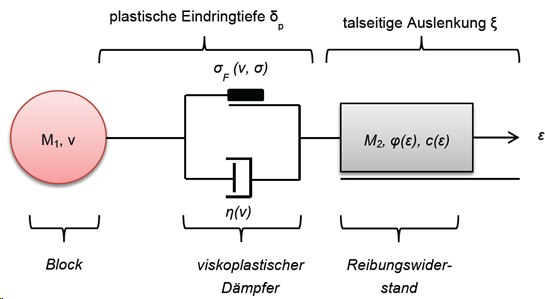This user manual is intended to focus on program operation. Therefore, this chapter only gives a very short overview of the partial models implemented in ROFMOD 5.0.
Detailed model descriptions are available for interested program users, which can be requested from GEOTEST AG, Zollikofen.
On this page you will find:
•Module protective measures: Protective dam
Central calculation module of ROFMOD 5.0 (Model Geotest+Zinggeler)
The fall of a block is modelled as a sequence of contact reactions and flight parabolas as well as a rolling motion. The contact reactions are calculated at the intersection of the flight parabolas with the terrain model or with tree trunks. The block shape is defined by the length of the three main axes and a degree of rounding.

Fig.: Submodels of the central calculation module
The figure above gives a graphical overview of the subprocesses and their modelling approaches in the central calculation module of ROFMOD. The block is considered differently for the different subprocesses: Depending on the subprocess, the block shape and size (block axes ratios, model sphere), the mass or the center (center of mass) are relevant.
Module protective measures: Protective dam (Model Kretz)
The protective dams module can be used to simulate the effects of fall blocks on reinforced protective dams and thus provide a basis for the design of protective dams. Until now, there has been no satisfactory method for this.
The approximation of the highly dynamic impact process by a static equivalent force shows unsatisfactory results and often leads to an oversizing of the protective dam. For this reason, a new rheological model for the simulation of protective dams was developed. The results of the rheological model were checked and compared with selected field data/observations as well as with results of the static equivalent force method.
In the simple rheological model, the block penetrates the dam and a local plastic deformation of the dam occurs (see figure below). If the stress falls below the yield point, the friction body is activated and a global failure occurs and a deflection occurs on the valley side.

Fig. (in german): Structure of the rheological model for the physical mapping of an impact in a protective dam
In principle, only deformations can be calculated with the rheological model. A calculation of a safety factor (action vs. resistance) as described in standard SIA 260 (2013) does not make sense.
In the present rheological model, safety is calculated as the ratio between the thickness of the dam (dam cross-section at the impact point) and the total deformation (plastic penetration depth plus deflection downhill).
Copyright © 2017-2023 GEOTEST AG